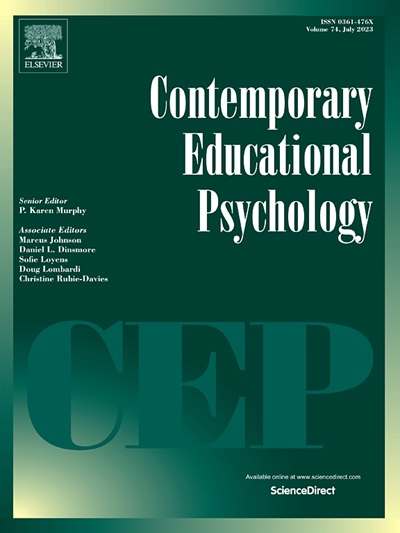学生心态意义系统的发展变化:感知课堂目标结构的作用
IF 3.8
1区 心理学
Q1 PSYCHOLOGY, EDUCATIONAL
引用次数: 0
摘要
心态通过塑造学生对努力和成就目标的信念来影响学习,创造两种不同的意义系统:成长心态-掌握目标系统和固定心态-表现目标系统。最近的研究表明,学生通常拥有与心态相关的信念和目标的更复杂的组合(概况)。然而,人们对这些概况如何随时间变化以及促成这些变化的环境因素知之甚少。本纵向研究采用面向模式的方法来调查:(a)基于学生心态、努力信念和目标的自然发生的概况;(b)这些剖面随时间的稳定性和变化;(c)感知课堂目标结构对剖面变化的影响。这项研究跟踪调查了430名学生(210名女生,年龄为12.86岁)中学前两年的情况。在这两年中,我们确定了四种一致的模式:成长型心态——低绩效目标,成长型心态——中等绩效目标,混合型心态——高绩效目标,以及固定心态——不投入。尽管“成长型心态-低绩效目标”在第一年的比例最大(32%),但随着时间的推移,人们对不太理想的心态有了明显的转变,而“固定心态-不投入”在第二年变得最常见(33%)。最初感知到高掌握和低绩效回避目标结构的学生更有可能属于并保持成长型心态。这些发现加深了我们对学生心态意义系统的性质、稳定性和语境影响的理解。本文章由计算机程序翻译,如有差异,请以英文原文为准。
Developmental changes in students’ mindset meaning systems: The role of perceived classroom goal structures
Mindsets impact learning by shaping students’ beliefs about effort and achievement goals, creating two distinct meaning systems: a growth mindset-mastery goal system and a fixed mindset-performance goal system. Recent studies reveal that students often hold more complex combinations (profiles) of mindset-related beliefs and goals. Yet, little is known about how these profiles change over time and the contextual factors that contribute to these changes. This longitudinal study used a pattern-oriented approach to investigate (a) the naturally occurring profiles based on students’ mindset, effort beliefs, and goals; (b) the stability and change in these profiles over time; and (c) the influence of perceived classroom goal structures on profile changes. The study followed 430 students (210 girls, Mage at Time 1 = 12.86 years) over the first two years of secondary school. Four consistent profiles were identified in both years: Growth Mindset-Low Performance Goals, Growth Mindset-Moderate Performance Goals, Mixed Mindset-High Performance Goals, and Fixed Mindset-Disengaged. Although the Growth Mindset-Low Performance Goals profile was the largest in the first year (32 %), there was a noticeable shift toward less desirable profiles over time, with the Fixed Mindset-Disengaged profile becoming the most common by the second year (33 %). Students who initially perceived high mastery and low performance-avoidance goal structures were more likely to belong to and remain in growth mindset profiles. These findings deepen our understanding of the nature, stability, and contextual influences on students’ mindset meaning systems.
求助全文
通过发布文献求助,成功后即可免费获取论文全文。
去求助
来源期刊

Contemporary Educational Psychology
PSYCHOLOGY, EDUCATIONAL-
CiteScore
16.50
自引率
3.90%
发文量
74
期刊介绍:
Contemporary Educational Psychology is a scholarly journal that publishes empirical research from various parts of the world. The research aims to substantially advance, extend, or re-envision the ongoing discourse in educational psychology research and practice. To be considered for publication, manuscripts must be well-grounded in a comprehensive theoretical and empirical framework. This framework should raise critical and timely questions that educational psychology currently faces. Additionally, the questions asked should be closely related to the chosen methodological approach, and the authors should provide actionable implications for education research and practice. The journal seeks to publish manuscripts that offer cutting-edge theoretical and methodological perspectives on critical and timely education questions.
The journal is abstracted and indexed in various databases, including Contents Pages in Education, Australian Educational Index, Current Contents, EBSCOhost, Education Index, ERA, PsycINFO, Sociology of Education Abstracts, PubMed/Medline, BIOSIS Previews, and others.
 求助内容:
求助内容: 应助结果提醒方式:
应助结果提醒方式:


